Someone to Watch over Earth
Neil Armstrong, an American astronaut and the first man to walk on the Moon, once said of his journey, “It suddenly struck me that that tiny pea, pretty and blue, was the Earth. I put up my thumb and shut one eye, and my thumb blotted out the planet Earth. I didn’t feel like a giant. I felt very, very small.”
In many ways, the university’s Nelson Institute for Environmental Studies was created four decades ago to watch over that tiny pea. The institute has played a steadfast leadership role in this arena, from examining local concerns about Madison’s lakes to tackling the global issues of climate change. The institute adopted its current name in 2002 to honor the late Gaylord Nelson LLB’42, former Wisconsin governor and U.S. senator, and the founder of Earth Day.
As both the institute and Earth Day reach fortieth anniversaries in 2010, On Wisconsin looks at how compelling films can build awareness of environmental issues and notes the UW’s remarkable connection to three of the most influential environmentalists in American history. To commemorate these milestones, the institute is sponsoring a public conference, Earth Day at 40, and an environment-themed concert at the Overture Center for the Arts, both in April.
In addition, a traveling mini-festival is planned to continue conversations about the environment that began during the 2009 Tales from Planet Earth, a festival that featured fifty films from around the world. (See story, below.) This spring, the Wisconsin Humanities Council is hosting Making It Home film festivals in Baraboo, Dodgeville, Milwaukee, and the Ashland/Bayfield area in Wisconsin. Following the films, people will discuss what defines their homes and communities, their cultural and historical ties, and environmental and social-justice challenges they face.
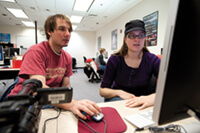
Jesse Mursky-Fuller x’11 (left) works with Maggie Flamingo PhDx’11 to edit a video project as part of a class offered last fall. Students learned how to use the artistry of film to convey messages about the environment, and to then spur audience members to apply what they’ve learned to tackle problems at the community level. Photo: Jeff Miller
Making a Reel Difference
Take one environmental film festival, add two classes of enthusiastic students, and mix with community groups in need of partners.
Gregg Mitman believes in the power of film to change lives. He should — he’s living proof that a good tale, told with passion and heart, can influence the way an audience regards our planet.
As a youngster, Mitman MA’84, PhD’88 was enthralled by the 1960s television programs The Undersea World of Jacques Cousteau and Flipper. That early enthusiasm led to a degree in biology and graduate degrees in the history of science, and today, Mitman is interim director of the UW’s Nelson Institute for Environmental Studies.
Ten years ago, he published an award-winning book, Reel Nature: America’s Romance with Wildlife Film, and a second edition was published last year. The book was the first to examine the enormous impact of nature films on how Americans see, think about, consume, and protect animals across the planet. Mitman, who holds appointments in medical history, and science and technology studies, teaches courses on the history of ecology, and the history of environment and health. He decided to draw upon the lessons of history, saying he wants to “open up what we think is a good environmental film and how we might tell other types of stories to change our interactions and attitudes.”
He had a chance to put those ideas to the test in 2007, when he organized a film festival, Tales from Planet Earth, as a project of the Nelson Institute’s Center for Culture, History, and Environment. He coupled the festival with a class in documentary storytelling, and students taking the course created short films that debuted at the event.
Judith Helfand, an award-winning environmental filmmaker and a UW-Madison Arts Institute artist-in-residence, collaborated with Mitman on the class and the festival. Helfand, too, was inspired by a story well told. After seeing “The Weavers: Wasn’t That a Time” on television in the 1980s, she was motivated to create documentaries that explore justice, equity, and the environment. In that film, Pete Seeger talks about art in the service of activism, and Helfand was smitten with his message and the power of nonfiction film. Today she is active with Working Films, an organization she co-founded that links nonfiction films with activism.
Tales from Planet Earth and its student films drew raves in 2007, Mitman says, but the audience was left with a now what? feeling. “There was so much enthusiasm from the last festival. We wanted to take that energy and turn it into community engagement and activism,” he says. “If you know something, you’ll care. And when you care, you’ll do something about it.”
With one festival behind them, Mitman and Helfand devised two courses that, together, could become a groundbreaking model. The first, a film production class, explores what constitutes an environmental film, then challenges students to create stories that use film’s artistry to engage an audience, create hope, and provide opportunities for action. The second class links storytelling with activism by partnering students with Madison-area nonprofit organizations that are dealing with issues raised in the festival’s films. Students are charged with linking one of the festival’s films with the needs of a community partner, then building an outreach campaign that is beneficial and measurable.
“I was thrilled to come back to Madison and to be able to bring and wear my Working Films hat,” says Helfand. “There is a new level of community engagement and interest among students. They want to be engaged in the world where they live while they are in school. My filmmaker friends are so jealous.”
Together, the classes and the festival created a compelling focal point for environmental storytelling. Held last November, the festival presented the best examples of the craft from the world’s filmmakers. Student-produced trailers addressed issues raised in the films, and community program leaders were present to show the audience members how they could take next steps. Forums and special events held before and after the films channeled new awareness into action. Students took big-picture topics raised by the film festival and turned them into local efforts. (See sidebar, below.)
Making all that happen — in just eight weeks or so — would send most people packing. But Mitman and Helfand viewed it as real-world experience, challenging the students to learn on their feet. During a boot camp held over two and a half days, students met their community partners, visited sites, and learned to listen to their partners’ needs and issues, while also being sensitive to the cultural and political dynamics in the organizations.
“Some of these students have lived in Madison for years, but have never left the campus. They are seeing that the issues raised in the films are very real, and real right here,” says Mitman. “They are also learning new ways to think about community service — where they learn about doing things with people, not for them. That builds relationships, trust, and follow-through.”
In the film production class, students learned how to use a camera, frame shots, edit footage, use sound and music, and truly understand the story — all while exploring how people shape and interact with the environment. It’s a tall order for neophyte filmmakers.
After learning the nuts-and-bolts aspects of hardware and software, the artistry enters. For a documentary to be effective, Helfand says, it must have high stakes: a relationship worth fighting for and a heart at risk of being broken. “Without heart and character, it’s just a lens and a camera. I want to teach the students to make moving moving pictures,” she says.
The student films explore topics ranging from the dairy industry’s dependence on Hispanic labor, to the story of an eighty-six-year-old woman from North Freedom, Wisconsin, who led a revolution in recycling plastics, to an example of how marketing food products for a housing organization can create jobs.
In turn, students in the community- engagement class had to quickly develop skills to broker real-world relationships, where the stakes are high. “This was not a typical class,” says Helfand. “The students were accountable to their [community] partners and learned lessons of tenacity, negotiation, and respect. What was hardest for them was also the most exciting. And best of all, they could see they had an impact.”
Knowing that people in the community were counting on them made students in both classes determined to commit significant time and energy. “[The students] were so respectful of the partners. … In return, the students earned their trust,” says Helfand.
Jesse Mursky-Fuller x’11 knew what he was getting into after taking the first film production class in 2007. Even so, when he had the chance in 2009, he enrolled in both classes. “I understand and agree with Gregg’s teaching philosophy — that is, experience and hands-on training [offer] the best way to learn. Just like science courses have lab sections, Gregg’s classes are labs for community engagement and film production,” says Mursky-Fuller, who is double-majoring in biology and life science communications.
His film, More Jam, More Jobs, demonstrates what can happen when the film, the classes, and the community cross-pollinate. It follows fellow student Jessica Halpern x’10, who — tray in hand — tries to convince twelve sororities to buy food items (such as fruit preserves) produced by Porchlight, Inc., a Madison housing advocacy group. After the festival’s screening of More Jam, there was standing room only for a tasting of Porchlight products.
Although he wasn’t sure what the community-engagement class would entail, Mursky-Fuller says he was happy as the experience unfolded. “That’s what’s nice about these classes — different issues and problems will present themselves each time. It’s not textbook material,” he says.
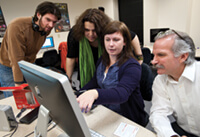
Kevin Gibbons MSx’11 and Judith Helfand, artist-in-residence, (both standing) look on as Meridith Beck Sayre PhDx’11 describes her video project for a class taught by Professor Gregg Mitman (far right) and Helfand. Photo: Jeff Miller
Public engagement is a core mission not just of the Nelson Institute but also of the campus in general, says Mitman. And he sees film as the perfect catalyst not only to bring the university and the community together, but also for weaving together perspectives from the humanities, social sciences, and sciences. “It’s such an effective medium to see relationships — often hidden from view — in a new light and to harness the power of storytelling to effect environmental and social change,” Mitman says. “Environmental film festivals on college campuses are growing, and I wanted to create a model for others to follow. The classes are a true expression of the Wisconsin Idea.”
Gwen Evans ’79, a senior university relations specialist for University Communications, never turns down the chance to see a good film.
Published in the Spring 2010 issue

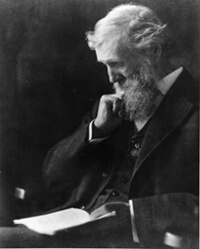

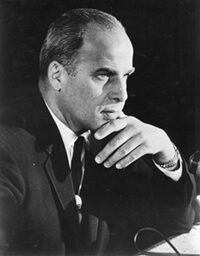



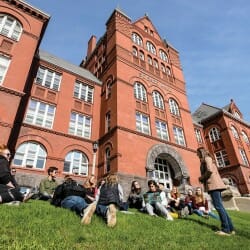
Comments
Gary Steuck April 27, 2010
Bit of an issue on the John Muir “sailing trip through the Panama Canal” in the 1860s. Construction didn’t start until 1880 and was completed in August, 1914, just four months before Muir died.
Great article except for that reference.